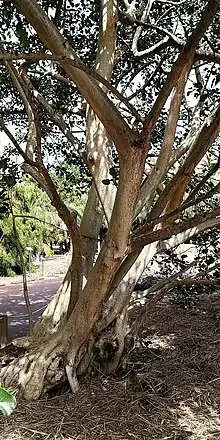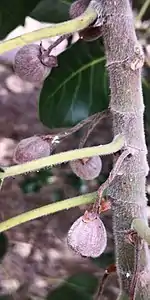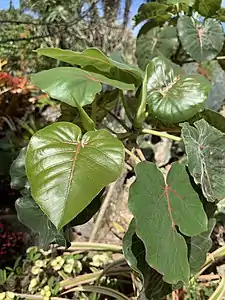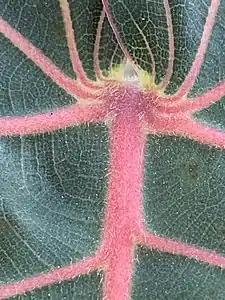Ficus petiolaris
Ficus petiolaris, commonly known as the petiolate fig and rock fig, is a fig that is endemic to Mexico from Baja California and Sonora south to Oaxaca. It grows from 10–20 feet high. It grows best with moderate water and partial shade. A unique feature is white hairs on the vein axils.[2] Other common names include the Baja California rock fig, Palmer wild fig, and Brandegee wild fig.[1]
| Ficus petiolaris | |
|---|---|
 | |
| Scientific classification | |
| Kingdom: | Plantae |
| Clade: | Tracheophytes |
| Clade: | Angiosperms |
| Clade: | Eudicots |
| Clade: | Rosids |
| Order: | Rosales |
| Family: | Moraceae |
| Genus: | Ficus |
| Subgenus: | F. subg. Urostigma |
| Species: | F. petiolaris |
| Binomial name | |
| Ficus petiolaris | |
| Synonyms[1] | |
| |
Description
They are trees that reach a size of 30 metres in height, or 8 to 10 m when it's cultivated as a houseplant. The trunk has a yellowish greenish color. The leaves are heart-shaped, on the front they are bright green and on the back they have a tuft of whitish hairs. The flowers and fruits are green, spherical in shape, with red and velvety spots. The crown of the tree is rounded.
Taxonomy
Taxonomic history
German botanist Carl Sigismund Kunth described this species in 1817.[3][4]
Etymology
Ficus: generic name that is derived from the Latin name given to the fig .
Petiolaris: Latin epithet meaning "with petiole".
Distribution and habitat
Originally from Mexico, it is present in warm, semi-warm and temperate climates, between 550 and 1200 meters above sea level. Wild plant, associated with deciduous and sub-deciduous tropical forests, thorny forest, mesophilic mountain forest, oak and pine forests.[5] In the Baja California Peninsula, this plant occurs from the southern Sierra de la Asamblea in central Baja California south into the Cape region of Baja California Sur, also present on many adjacent Gulf of California islands.[1]
Uses
The bark was traditionally used by the Aztecs to make paper, known as amate. Many of the remaining Aztec codices were written on amate.
In the 16th century, Francisco Hernández de Toledo relates: "the cooking of the roots and bark moisten the tongue of those who have a fever, relieves the pains of the chest and if they are not removed milk evacuates bile and phlegmatic humors by the Upper or lower duct. Cure inveterate ulcers of the lips or any other. " In the 20th century, Maximino Martinez, referred to as astringent, to heal fractures, cracks in gums, herpes and pectoral.[6]
In Mexico, this species is recommended against intestinal parasites, herpes, cough, spleen stones, to regulate menstruation and heal fractures.
In Sonora it is advised in cases of goiter, chest pains, phlegm, wounds and ulcers. In Morelos it is used to attenuate the fever. The treatment includes latex, juice or resin.
In Michoacán, against the hepatitis the macerated bark is prepared and put to soak one day to apply baths, in addition to taking it fasting for nine days.[7]
Gallery
.jpg.webp) Young plant
Young plant Fruits
Fruits Leaves
Leaves White hairs along vein axils
White hairs along vein axils
References
- Rebman, J. P.; Gibson, J.; Rich, K. (2016). "Annotated checklist of the vascular plants of Baja California, Mexico" (PDF). San Diego Society of Natural History. 45: 200.
- "Ficus petiolaris". Missouri Botanical Garden. Retrieved May 23, 2017.
- F. W. H. A. von Humboldt et al., Nov. gen. sp. 2:40[folio]; 2:49[quarto]. 1817
- "16933". Germplasm Resources Information Network. Agricultural Research Service, United States Department of Agriculture.
- Carvajal, S., RR Espinosa & HP Juárez. 2000. New combinations in species of the genus Ficus L. subgen. Urostigma (Moraceae) from Mexico. Bol. Inst. Bot. (Univ. Guadalajara) 8 (1-2): 127-136.
- Shreve, F. & IL Wiggins. 1964. Veg. Fl. Sonoran Des. 2 vols. Stanford University Press, Stanford.
- Davidse, G., M. Sousa Sánchez, S. Knapp & F. Chiang Cabrera. 2014. Saururaceae to Zygophyllaceae. 2 (3): ined. In G. Davidse, M. Sousa Sanchez, S. Knapp & F. Chiang Cabrera (eds.) Fl. Mesoamer .. National Autonomous University of Mexico, Mexico.